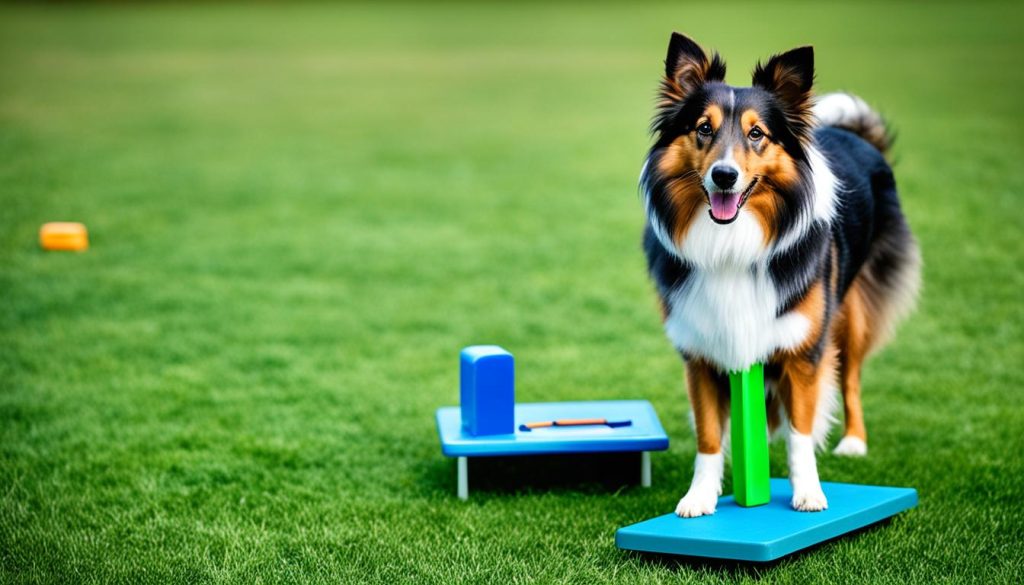Shetland Sheepdog training requires understanding their unique characteristics and needs. These intelligent and energetic dogs thrive with consistent training and mental stimulation. In this article, I will share various techniques and tips to help you effectively train your Shetland Sheepdog, or Sheltie, and address specific behaviors.
Shetland Sheepdog Training
- Consistent training and mental stimulation are crucial for Shetland Sheepdogs.
- Understanding the Sheltie’s background and nature is essential for effective training.
- Prioritizing the health and care of your Sheltie is important alongside training.
- Employ positive reinforcement and appropriate training techniques for success.
- Address common behavioral issues with tailored methods for Shelties.
Understanding the Sheltie’s Nature and Background
Shelties, also known as Shetland Sheepdogs, have a fascinating herding history and possess unique traits that make them beloved companions. Their loyalty and intelligence set them apart, but it’s important to understand their nature and background to effectively train them.
When it comes to shetland sheepdog puppy training, starting early is key. By beginning training during their puppy stage, you can establish good habits and provide a strong foundation for future training success. Early training allows you to shape their behavior and instill necessary commands and obedience.
Utilizing the best Shetland Sheepdog training methods is crucial for achieving the desired results. Positive reinforcement, reward-based training, and consistency are effective techniques to guide your Sheltie towards good behavior. These methods promote a loving and respectful bond between you and your furry companion.
While training your Shetland Sheepdog at home is essential, enrolling in shetland sheepdog training classes can provide additional benefits. These classes offer professional guidance and socialization opportunities for your Sheltie. Interaction with other dogs and experienced trainers helps your Sheltie learn how to socialize, behave in public, and respond to commands in different environments.
Overall, understanding the nature, background, and specific training methods for Shelties is crucial for successful Shetland sheepdog puppy training. By starting early, utilizing effective training techniques, and considering professional training classes, you can ensure a well-behaved and happy Shetland Sheepdog.
Health and Care for Shelties
Aside from training, it’s essential to prioritize the health and care of your Sheltie. This section will provide a comprehensive guide that covers various aspects, including nutrition, grooming rituals, health concerns, and handling medication and treats. Additionally, we will share valuable Shetland Sheepdog training resources, programs, and general dog training tips for a well-rounded approach to your Sheltie’s overall well-being.
Proper nutrition plays a vital role in maintaining your Sheltie’s health. Feed them a balanced diet consisting of high-quality dog food. Ensure the food is appropriate for their age, size, and activity level. Talk to your veterinarian to determine the ideal diet for your Sheltie.
Grooming is an essential part of Sheltie care. Their thick double coat requires regular brushing to prevent matting and minimize shedding. Set a grooming routine that includes brushing their coat, cleaning their ears, trimming their nails, and brushing their teeth.
When it comes to health concerns, Shelties may be prone to certain conditions such as hip dysplasia, eye issues, and allergies. Regular veterinary check-ups are crucial to detect any potential problems early on. Stay informed about common Sheltie health issues and take preventative measures to ensure their well-being.
Shetland Sheepdog Training Resources and Programs
As you focus on training your Sheltie, it’s beneficial to leverage available Shetland Sheepdog training resources and programs. These resources offer expert guidance and valuable tips to enhance your training efforts. Online forums, blogs, and websites dedicated to Sheltie training can provide a wealth of information and solutions to common training challenges. Make use of trustworthy training resources to support your training journey.
Additionally, consider enrolling your Sheltie in professional training programs. These programs often provide structured training sessions and guidance from experienced trainers who specialize in Shetland Sheepdog training. Taking part in training programs can accelerate your Sheltie’s learning process and ensure a well-rounded training experience.
Dog Training Tips
In addition to specific Shetland Sheepdog training resources, incorporating general dog training tips into your training routine can be highly effective. Here are some valuable tips:
- Consistency is key: Establish consistent routines and training methods to promote understanding and reinforce desired behaviors.
- Positive reinforcement: Reward your Sheltie with praise, treats, or playtime when they exhibit good behavior. This encourages them to repeat the desired actions.
- Patience and persistence: Training takes time, so be patient and persistent. Break down commands into small steps and gradually increase difficulty.
- Use clear and concise cues: Use consistent verbal and visual cues to communicate with your Sheltie effectively.
- Never punish or yell: Avoid punishment-based training methods as they can create anxiety and damage the trust between you and your Sheltie. Instead, focus on positive reinforcement.

By prioritizing your Sheltie’s health and care while utilizing valuable training resources and tips, you can create a harmonious and fulfilling life for your beloved companion.
Effective Training Techniques for Shelties
Shetland Sheepdogs, or Shelties, are highly trainable dogs that respond well to effective training techniques. By utilizing methods that prioritize positive reinforcement and clear communication, you can establish a strong foundation for your Sheltie’s obedience and well-being.
The Importance of Positive Reinforcement
Positive reinforcement is a key component of training Shelties. By rewarding desired behaviors with treats, praise, or playtime, you create a positive association that encourages your Sheltie to repeat those actions. This method increases your dog’s motivation to learn and fosters a trusting and cooperative relationship between you and your Sheltie.
Leash Training for Controlled Walks
Leash training is essential for a Sheltie’s safety and your peace of mind during walks. Begin by introducing your dog to the leash gradually, allowing them to become comfortable with its presence. Once your Sheltie is accustomed to the leash, teach them to walk calmly by your side without pulling. Use positive reinforcement to reward them for staying close and following your cues. With patience and consistency, your Sheltie will learn to enjoy controlled walks and behave well on the leash.
Obedience Training for Well-Behaved Shelties
Obedience training lays the groundwork for a well-behaved Sheltie that understands and follows basic commands. Start by teaching essential commands like sit, stay, come, and lie down. Break the training into short sessions and use positive reinforcement to reward your Sheltie’s compliance. Consistency and repetition are key in obedience training, so practice regularly and gradually introduce new commands as your Sheltie progresses.
Remember, each Sheltie is unique, and training methods may vary. It’s important to assess your dog’s individual needs and adjust your techniques accordingly. With patience, positive reinforcement, and proper training techniques, you can shape your Sheltie into a well-trained and obedient companion.
Addressing Common Behavioral Issues in Shelties
Shelties, like any other breed, can sometimes exhibit certain behavioral issues that may require attention and training. In this section, I will provide you with effective techniques and methods to address common behavioral problems specific to Shelties, such as excessive barking, separation anxiety, and play biting.
Excessive Barking
Shelties are known to be vocal dogs, but excessive barking can be a problem if left unchecked. To address this issue, it is important to understand the underlying reasons behind your Sheltie’s barking. It could be due to boredom, fear, or territorial behavior. By identifying the root cause, you can tailor your training approach accordingly.
One effective method to reduce excessive barking is to teach your Sheltie the “quiet” command. Whenever your dog starts barking unnecessarily, calmly say “quiet” and wait for a moment of silence. Reward your Sheltie with praise and treats when they stop barking. Consistency and positive reinforcement will help your Sheltie understand that staying quiet is rewarded.
Separation Anxiety
Shelties are known to be highly affectionate and attached to their owners, which can sometimes lead to separation anxiety. This can manifest as destructive behaviors, excessive barking, or even house soiling when left alone.
To address separation anxiety, it is important to gradually desensitize your Sheltie to your departures. Start with short periods of time away and gradually increase the duration. Make departures and arrivals low-key to avoid triggering anxiety. Providing your Sheltie with interactive toys and creating a safe space with their favorite blankets or toys can also help alleviate anxiety.
Play Biting
Sheltie puppies, like many other breeds, tend to explore the world with their mouths, which can result in play biting. While it may seem harmless during their early stages, if not corrected, it can develop into an undesirable behavior.
To discourage play biting, it is crucial to establish boundaries and teach bite inhibition. Whenever your Sheltie puppy nips or bites during play, let out a high-pitched yelp to mimic the sound of a littermate in pain. This will help them understand that biting is not acceptable. Provide them with appropriate chew toys to redirect their biting behavior. Consistency and positive reinforcement will help your Sheltie learn appropriate play behavior.
By addressing these common behavioral issues using specific Shetland Sheepdog obedience training methods and techniques, you can create a harmonious environment for both you and your Sheltie. Remember to be patient, consistent, and use positive reinforcement to achieve the desired results. Training your Sheltie will not only correct problematic behaviors but also strengthen the bond between you and your furry companion.

Tailoring Exercise and Mental Stimulation for Shelties
Shelties are known for their high energy levels and intelligence, making regular exercise and mental stimulation essential for their overall well-being. By understanding their unique breed characteristics and tailoring their exercise routines, you can ensure that your Sheltie remains happy and healthy.
When it comes to basic commands training, consistency is key. Shelties are highly trainable dogs, and with patience and positive reinforcement, they can quickly learn and master commands such as sit, stay, and come. Remember to reward your Sheltie with treats and praise when they correctly execute a command, reinforcing their positive behavior.
Housebreaking is another crucial aspect of Sheltie training. With consistency and a regular routine, you can successfully housebreak your Sheltie. Take your dog outside frequently, especially after meals and naps, and praise them when they eliminate in the appropriate area. Use positive reinforcement to encourage good habits and discourage accidents indoors.
Exercise and Mental Stimulation Activities
To keep your Sheltie physically and mentally engaged, incorporate the following activities into their daily routine:
- Long walks or jogs: Shelties have a lot of energy to burn, so regular exercise is essential. Take them for long walks or engage in a jogging session to provide them with the physical exercise they need.
- Interactive toys: Invest in puzzle toys or treat-dispensing toys that challenge your Sheltie’s problem-solving skills and keep them mentally stimulated. These toys can provide hours of entertainment while keeping their minds sharp.
- Agility training: Shelties excel in agility courses, which involve navigating through tunnels, jumping over hurdles, and weaving through poles. Consider enrolling your Sheltie in agility training classes to provide them with a structured and challenging activity.
- Playdates and socialization: Shelties are social dogs that enjoy the company of other dogs. Organize playdates with friendly dogs in a safe and controlled environment to provide your Sheltie with social interaction and playtime.
- Hide and seek: Engage your Sheltie in a game of hide and seek by hiding treats or toys around the house or in the backyard. This game taps into their natural instinct to search, keeping them mentally stimulated and entertained.
Remember, each Sheltie is unique, so find activities that align with their interests and energy levels. By tailoring exercise and mental stimulation to their specific needs, you can ensure that your Sheltie remains happy, healthy, and well-behaved.
Conclusion
Training a Shetland Sheepdog, or Sheltie, can be a deeply fulfilling journey that strengthens the bond between you and your furry companion. With the right approach, patience, and consistency, you can transform your Sheltie into a well-behaved and obedient member of your family.
Throughout this article, we have shared valuable shetland sheepdog training tips and insights to help you achieve success. By implementing effective training techniques, such as positive reinforcement and obedience training, you can bring out the best in your Sheltie and nurture their intelligence and loyalty.
Remember that training is a continuous process. Even after achieving initial success, it is important to reinforce and build upon the foundation you have established with your Sheltie. With dedication and ongoing training, you can unlock the full potential of your Shetland Sheepdog and ensure a harmonious relationship filled with love, respect, and understanding.
FAQ
When should I start training my Shetland Sheepdog puppy?
It’s important to start training your Shetland Sheepdog puppy as early as possible to establish good habits and a strong foundation.
What are the best Sheltie training methods?
The best Sheltie training methods include positive reinforcement, consistency, and patience.
Should I consider enrolling my Shetland Sheepdog in training classes?
Enrolling your Shetland Sheepdog in training classes can be beneficial as they provide structured training and socialization opportunities.
How can I ensure the health and care of my Sheltie?
To ensure the health and care of your Sheltie, make sure to prioritize their nutrition, grooming, and regular vet check-ups.
Are there any recommended Shetland Sheepdog training resources or programs?
Yes, there are various Shetland Sheepdog training resources and programs available, such as books, online courses, and professional trainers.
What are some effective training techniques for Shelties?
Effective training techniques for Shelties include positive reinforcement, proper leash training, and obedience training.
How can I address common behavioral issues in Shelties?
To address common behavioral issues in Shelties, it’s important to understand their nature and use specific training methods tailored to their needs.
How can I tailor exercise and mental stimulation for my Shetland Sheepdog?
Tailoring exercise and mental stimulation for your Shetland Sheepdog involves understanding their breed characteristics and incorporating activities that suit their energy levels and instincts.






